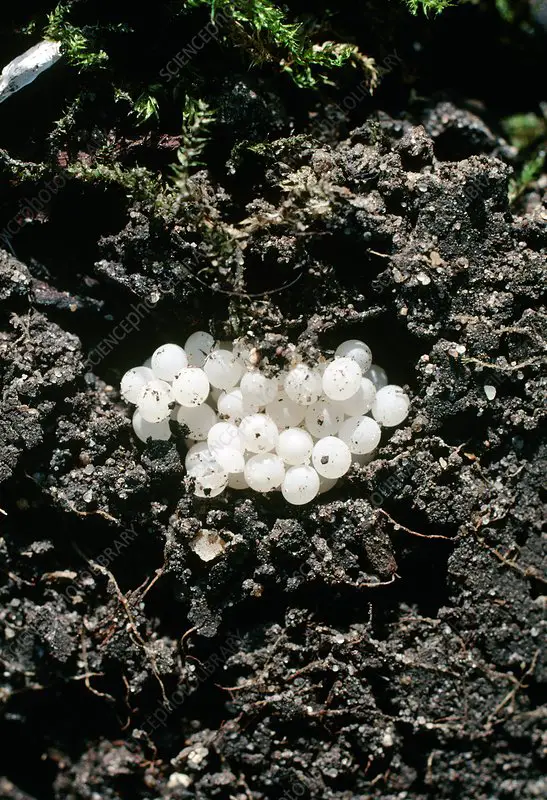Introduction
Gardeners often encounter unusual formations in the soil that raise concern or curiosity. Among the most common and easily misidentified findings are clusters of small white or translucent spheres. These round, pearl-like balls typically turn out to be snail or slug eggs.
Although they may appear harmless, these eggs can present significant challenges for gardens, particularly when they belong to invasive or parasitic species. Understanding what these spheres are, how to identify them, and how to respond safely is essential for maintaining a healthy growing environment.
This article explains the nature of these formations, potential risks they pose, and the most effective prevention and control measures.

Appearance and Initial Identification
Snail and slug eggs are small, round, and slightly translucent, often resembling tapioca pearls or beads of gelatin. They are generally 1–3 millimeters in diameter and typically appear in clusters containing dozens or even hundreds of eggs.
These clusters are usually found just beneath the surface of moist soil, near shaded, protected areas such as under mulch, garden debris, or plant leaves. In some cases, they are laid close to garden beds or in the soft soil surrounding vegetables and herbs.
A few characteristics help distinguish them from other possible formations:
-
Shape: Perfectly spherical, smooth, and uniform.
-
Color: White to slightly translucent; sometimes light gray or off-white.
-
Texture: Soft and flexible, yielding slightly under pressure.
-
Contents: When viewed under light, faint gray or black dots can often be seen inside, indicating developing embryos.
-
Arrangement: Grouped closely together, often in small cavities or depressions in the soil.
These features differentiate snail eggs from inorganic materials such as fertilizer granules or beads, which are typically harder and uniform in color, or fungal spores, which are powdery rather than gelatinous.
Why Snails Lay Eggs in Garden Soil
Snails prefer to lay their eggs in cool, damp, and protected environments, making garden soil an ideal location. Moisture helps maintain the soft structure of the eggs and prevents them from drying out.
Female snails bury their eggs just below the surface to protect them from predators and temperature fluctuations. Depending on the species, each snail can lay between 50 and 400 eggs at a time, repeating the process multiple times throughout the year.
Warm, humid conditions — particularly following rainfall — encourage snails to reproduce rapidly. In regions with mild winters, they may breed almost year-round, creating continuous population pressure if not controlled.
Common Misidentifications
Because of their unusual appearance, snail eggs are frequently confused with other substances found in soil. Below are common misinterpretations:
-
Fertilizer Pellets: These are hard and uniformly colored, often blue or green, whereas snail eggs are soft and translucent.
-
Fungal Growths: Certain fungi form small white nodules, but these are attached to decaying organic matter rather than clustered within moist soil pockets.
-
Insect Eggs: Insect eggs are often enclosed in fibrous sacs or attached to leaves, while snail eggs are found buried below the surface.
-
Expanded Polystyrene or Plastic Beads: Occasionally, small plastic remnants appear in soil, but they do not rupture under pressure or contain internal material.
Proper identification is crucial, as treating them incorrectly can either waste effort or, worse, harm beneficial organisms in the soil.
Ecological and Agricultural Risks
While many native snails play a minor role in the ecosystem, invasive species can cause extensive damage to gardens and crops. Their eggs are the beginning of infestations that may devastate vegetation in a short period of time.
1. Plant Damage
Newly hatched snails feed on tender plant tissue, including seedlings, stems, and leaves. A large infestation can strip foliage overnight, reducing plant vigor and yield.
2. Rapid Reproduction
Some species, such as the Giant African Snail (Achatina fulica), can produce up to 1,000 eggs per year. Without intervention, populations grow exponentially.
3. Disease and Parasite Transmission
Certain snails carry Angiostrongylus cantonensis, known as the rat lungworm, a parasite capable of infecting humans and animals. While transmission is rare in temperate climates, handling eggs or produce contaminated by infected snails without proper hygiene presents a potential health risk.
4. Ecosystem Disruption
Invasive snails compete with native invertebrates for food and habitat, leading to decreased biodiversity. They also contribute to the spread of plant pathogens by carrying fungal spores and bacteria on their mucus trails.
Safe Handling Procedures
When unidentified spherical objects are found in garden soil, proper safety precautions are recommended:
-
Wear gloves before touching or removing any unknown material.
-
Avoid crushing eggs bare-handed, as some species release irritants or parasites.
-
Do not relocate soil that may contain eggs to other parts of the garden; this can spread the infestation.
-
Wash hands and tools thoroughly after contact, even when gloves are used.
If there is uncertainty regarding identification, samples can be photographed and compared with verified images from agricultural extension resources or local environmental agencies.
Effective Removal and Destruction Methods
Once snail eggs are confirmed, immediate removal helps prevent hatching and future infestations. Several methods are proven effective and environmentally safe.
1. Manual Removal
Use a trowel or small shovel to scoop out the cluster of eggs and surrounding soil. Place them in a sealed container or bag. Do not dispose of them directly into compost, as the eggs may survive and hatch later.
2. Hot Water Treatment
Pouring boiling water over collected eggs or contaminated soil effectively destroys them. The heat denatures the soft tissue within seconds without the need for chemical treatments.
3. Freezing
For small infestations, placing sealed bags containing the eggs in a freezer for 24–48 hours can achieve similar results.
4. Soil Solarization
In larger areas, covering the soil with clear plastic sheets for several weeks under direct sunlight raises the temperature enough to kill hidden eggs and larvae.
5. Biological and Natural Barriers
Introducing natural deterrents, such as copper strips around garden beds, crushed eggshells, or diatomaceous earth, can reduce egg-laying by adult snails.
Preventive Garden Management
Long-term prevention focuses on making the environment less attractive to snails and maintaining regular monitoring routines.
Maintain Dry Conditions
Snails prefer moisture. Avoid overwatering, and ensure good drainage around plants. Water early in the day so the soil surface dries by evening, discouraging nighttime activity.
Reduce Shelter Opportunities
Remove garden debris, stones, wood pieces, and dense mulch layers where snails hide during the day. Trim lower leaves of plants to improve air circulation and light penetration.
Regular Inspection
Examine soil after rain or watering sessions. Look for new clusters and remove them promptly before hatching occurs.
Use of Barriers and Traps
-
Copper Tape: A physical deterrent that prevents snails from crossing garden borders.
-
Beer Traps: Shallow containers filled with beer attract and drown snails.
-
Natural Predators: Encourage populations of ground beetles, frogs, and birds that naturally prey on snails.
Plant Selection
Some plants, such as rosemary, lavender, and ferns, are naturally resistant to snail feeding. Incorporating these can help reduce overall snail presence.
Understanding the Life Cycle
Recognizing the life cycle of snails helps predict their activity and prevent recurring problems.
-
Egg Stage: Eggs hatch within 2–4 weeks depending on temperature and humidity.
-
Juvenile Stage: Newly hatched snails begin feeding immediately and reach maturity within a few months.
-
Adult Stage: Once mature, snails can reproduce several times per year, especially in favorable weather conditions.
Interrupting this cycle — primarily by eliminating eggs before hatching — is the most effective form of control.
Environmental Considerations
While control is necessary, it should be done responsibly to avoid harming beneficial soil organisms.
-
Avoid chemical pesticides unless infestations are severe, as they can damage pollinators and soil microbiota.
-
Encourage biodiversity by maintaining balanced ecosystems; natural predators keep snail populations in check.
-
Compost carefully — only add organic matter free from visible eggs.
-
Inspect new plants and soil before introducing them to existing garden beds, as imported materials often carry hidden eggs or larvae.
Hygiene and Food Safety
Because some snails may carry parasites capable of affecting humans, hygiene should never be neglected in gardens used for growing edible produce.
-
Always wash vegetables and herbs thoroughly before consumption.
-
Soak leafy greens in a vinegar-water solution to eliminate possible contaminants.
-
Use gloves when harvesting or cleaning produce from areas known to have snail activity.
-
Keep garden tools clean and dry after use to prevent the spread of slime trails that can contain bacteria or parasites.
These small precautions significantly reduce any potential health risks.
When to Seek Expert Assistance
If egg clusters are repeatedly found despite preventive measures, or if the species appears unusual or oversized, contact local agricultural or environmental authorities. They can assist with:
-
Species identification to determine if it is invasive.
-
Guidance on safe eradication consistent with regional environmental policies.
-
Recommendations for biological control programs using natural predators or nematodes specific to snail species.
Prompt expert evaluation helps prevent local outbreaks and protects both private and public green spaces.
Summary of Key Actions
| Objective | Recommended Action |
|---|---|
| Identification | Confirm by texture, color, and translucence |
| Safety | Wear gloves, avoid direct contact |
| Removal | Extract with trowel; do not compost |
| Destruction | Use boiling water, freezing, or solarization |
| Prevention | Maintain dry soil, install barriers, inspect regularly |
| Hygiene | Wash produce, disinfect tools |
Conclusion
Discovering small white spheres in garden soil can be unsettling, but recognizing them for what they are — snail eggs — provides the first step toward effective management. These eggs are a natural part of the environment, yet when left unchecked, they can signal the beginning of an infestation capable of damaging crops and spreading unwanted organisms.
By combining accurate identification, safe handling, and preventive measures, gardeners can control snail populations without disrupting the ecological balance of their gardens.
Maintaining awareness and routine inspections ensures that your garden remains both productive and safe — a space where the unseen life beneath the soil coexists responsibly with the plants and people above it.

Adrian Hawthorne is a celebrated author and dedicated archivist who finds inspiration in the hidden stories of the past. Educated at Oxford, he now works at the National Archives, where preserving history fuels his evocative writing. Balancing archival precision with creative storytelling, Adrian founded the Hawthorne Institute of Literary Arts to mentor emerging writers and honor the timeless art of narrative.
